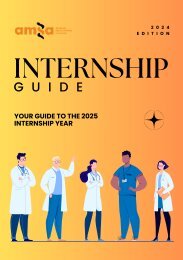AJGH Nexus - Volume 17 2023
AMSA Journal of Global Health (AJGH) 2023 Issue "Nexus"
AMSA Journal of Global Health (AJGH) 2023 Issue "Nexus"
Create successful ePaper yourself
Turn your PDF publications into a flip-book with our unique Google optimized e-Paper software.
<strong>Volume</strong> <strong>17</strong> | <strong>2023</strong><br />
4.2 Comparison to other studies<br />
The pattern of responses to the worry scale<br />
questionnaire shared similarities with studies<br />
conducted in Ethiopia and Norway as well as<br />
longitudinal research being conducted in<br />
Australia,[11,15, 25] using a similar questionnaire<br />
(Table 4).<br />
The Australian SCRUB (Survey of COVID-19<br />
Responses to Understand Behaviour) study has<br />
been tracking behaviour and concerns about<br />
COVID-19 in the Australian population through<br />
repeated cross-sectional and longitudinal<br />
sampling.[25] During the same time period as<br />
our study, the top four most worrisome<br />
questions from the SCRUB data all related to the<br />
economic and personal financial situation at the<br />
time. Differences in findings between the SCRUB<br />
study and our findings may be due to differences<br />
in recruitment approaches, timing of survey and<br />
sample demographics.<br />
4.3 Implications of our results<br />
These results suggest that worry about the<br />
COVID-19 pandemic is complex and different<br />
worries interact with each other. Understanding<br />
the pattern of worry could be utilised to inform<br />
public health interventions to slow transmission.<br />
An approach that is informed by this pattern<br />
may reduce harmful and distressing levels of<br />
worry by empowering people to become active<br />
participants in preventing what worries them.<br />
Examples of how public health messages could<br />
be framed to respond to common worries<br />
highlighted in our results could be, “Wash your<br />
hands to protect your loved ones from<br />
coronavirus” or “Wear a mask when out and<br />
about to get back to supporting local<br />
businesses”. Additional, potentially pro-active<br />
support could also be offered to people living<br />
with pre-existing psychological<br />
distress/diagnosed mental health concerns.<br />
4.4 Limitations<br />
Compared to other threats and disasters,<br />
relatively little is known about concerns in a<br />
pandemic.[26] The urgency of the COVID-19<br />
situation confers limitations to research into<br />
behaviour and peoples’ perceptions of the<br />
response and validation studies for the items on<br />
our survey are yet to be undertaken.[6] There<br />
were several biases introduced in this study<br />
mainly through the inclusion criteria of engaging<br />
in paid or voluntary work. This decreased the<br />
likelihood of selecting financial concerns as one<br />
of their main worries. Additionally, bias was also<br />
introduced through distributing the survey via<br />
email to pre-existing contacts, as it was<br />
predominantly females who worked in<br />
healthcare with tertiary level education who<br />
completed the survey.<br />
Furthermore, certain demographic aspects of<br />
the respondents to the survey means these<br />
results cannot be easily generalised to the wider<br />
population. The survey was distributed<br />
Australia-wide, but most respondents were<br />
female (80.4%) and lived in non-metropolitan<br />
areas (78.1%). The latter was not controlled for in<br />
our analysis and may have had an influence on<br />
the level of worry with the vast majority of<br />
COVID-19 cases in Australia occurring in<br />
metropolitan areas.[12] Further, the total<br />
percentage of respondents living with a chronic<br />
physical health condition was relatively low<br />
(21.1%) in comparison to the Australian<br />
population, with the Department of Health<br />
estimating 50% of Australians have at least one<br />
chronic health condition.[27]<br />
5. Conclusion<br />
This research contributes to an understanding of<br />
the patterns of pandemic-related worry.<br />
Personal and community health impacts of the<br />
virus and the consequences for the economy and<br />
the health system were consistently associated<br />
with a higher level of worry than other questions<br />
on the survey. Understanding this pattern has<br />
the potential to help inform the way public<br />
health messages should be communicated to<br />
maximise their health promoting benefits.<br />
Acknowledgements<br />
We would like to thank all the participants<br />
who kindly contributed to this study.<br />
Conflicts of Interest<br />
There are no conflicts of interest to declare.<br />
06

















